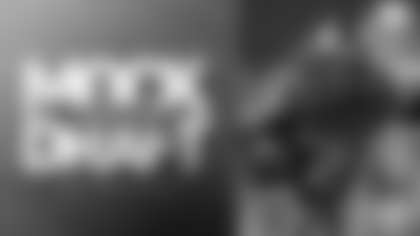Jaguars special teams coordinator Russ Purnell has no problem finding his way around Indianapolis, where he has spent the last three days at the NFL Scouting Combine. Purnell has been a fixture at the event since the late '80s and lived in the city for seven years as a member of the Colts coaching staff.
Purnell has noticed major changes in an event that is now covered by more than 400 media members and every drill, workout or interview is seen on NFL Network. He joined the rest of the Jaguars staff on Saturday inside Lucas Oil Stadium to evaluate this year's crop of punters and kickers. The 38-year coaching veteran sat down with jaguars.com to talk about the annual event, what he looks for this weekend and how the event has changed over the years.
*Do you remember anything about your first combine? *
My first combine was in 1987 and I think that was the first one in Indianapolis. The RCA Dome was only four old as the Colts just started playing there in 1984.
*They are reporting this week that there are more than 600 NFL personnel in Indianapolis this week to evaluate the prospects. I imagined it wasn't quite the same in 1987. *
I couldn't tell you how many were there, but it was not nearly as much. The number one thing is that the event is so much more organized and efficient now.
*How is it more efficient? *
For a number of years, they wouldn't get started until after 7 p.m. You were just sitting around there waiting, groups were getting backed up with the medical stations. They truly learned from experience how to manage the time and how to move people through the stations.
*This is my fifth combine and I'm amazed at the amount of media that covers this event now. *
Before John Clayton (ESPN) would be there and now you walk down the hall of the convention center and you see everybody standing there. In 1987, the people didn't really know what the combine was and now they are showing drills on television, players are keeping diaries, blogging and tweeting. It gets bigger and bigger.
When you go to the combine as a special teams coordinator, do you do the same thing as the other position coaches in terms of interviews? How do you find a Montell Owens type player at the combine?
Yes, we do the interviews and watch the workouts. There are some guys that have been identified by our scouts as productive special teams players in college. Guys that have either shown it in their careers whether it be their sophomore or junior year and didn't play much as a senior, or guys that have the characteristics. They could be a third safety but have a knack for playing special teams. I will talk to some of the guys this weekend who have been identified and then between now and the draft I will go look at those guys on tape as well. Look at four or five games and see how they play on special teams.
*Do the kickers even go through the physical tests? *
Most of them don't run it. They aren't required to run it. Now David Buehler from USC did a lot of those tests last year because he knew would do well. He ran the 40 and he bench-pressed 225 twenty-five times. That was more than some of the offensive linemen.
*How many field goals do the kickers attempt during their time on the field? *
They will have 15 field goals. They start with about a thirty-yard field and end up around the fifty-yard line.
*Is accuracy the most important you are looking for? *
You are looking for accuracy. You are looking at their mechanics, the profile of the ball. The one thing about these guys kicking is they don't have their holder and they don't have their snapper. Most of the guys that are punters will have a background in holding and some of the quarterbacks are holders. They will have those guys there to help out.
*Why aren't long snappers more a vital part of the process? *
That is one of several changes they have made in the special teams part. They brought in three or four long-snappers, guys that are truly long snappers so you can judge them.
*What other changes have they made? *
They have started to use K balls. They are not getting month-old footballs. Special teams coaches are now involved with setting up the drills and running them. Darrin Simmons from the Be*ngals has primarily been doing it the last couple of years. He was a punter at Kansas and he went to the combine so he went through it. He got input from special teams coaches. They started to include kickoffs and directional punting. They would do elevation tests. They would spot the ball seven yards from the crossbar and the guy would have to kick it over it. Then they would move it up to five yards. Well, guys were changing their swing so they can just pop it up over the post. Some guys were smart enough to do that and some weren't and they were banging them off the upright or kicking them underneath. Now, six yards is a better distance. Instead of wasting time, we just do five at the six-yard line and use the other five to do directional kickoffs. For example, I tell our protection group that we are lined up at eight (yards) and if a guy gets a push or jumps up, we can't give a guy two yards of push and have a defensive linemen jump up and touch the rim. If you are touching the rim then you are touching the crossbar. We can't let a guy do it. When I would drill with (Mike) Vanderjagt or (Adam) Vinatieri, I would pace off six yards from the crossbar and we would practice from there.
*Have you seen a lot of guys perfect on all their field goal attempts? *
There have been a number of guys that have been 15 for 15. You are kind of keeping track and say, 'Hey, this guy is back to 45 and hasn't missed yet.' The guy might go out there and hit 14 of 15 field goals but then all his kickoffs are coming down between the 15 and 10-yard line. Kickers do both, field goals and kickoffs.
*What are you looking for at the combine from the punters? *
I am looking for consistency. Number two, the get-off right at two seconds. The snap should be .75 and hand to foot at 1.25. That is one thing Adam (Podlesh) does well. He is consistently under 1.94 or 1.98 for a game.
*Is that something you can teach as a coach? *
Some bigger guys are slower because their steps are longer, but there are some things you can do to quicken a guy up. When you watch the guys at the combine and their hand to foot time, they aren't really pushing it. There is a snapper there and they are punting it. They are not really pushing the get-off time there because there is no rush. There is no one coming off the edge or trying to come up the middle to block the punt. These guys want to hit a good punt so they are taking a little extra time. *














